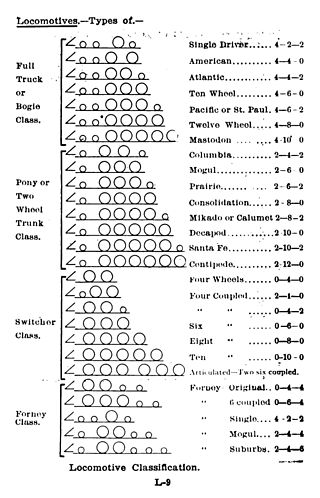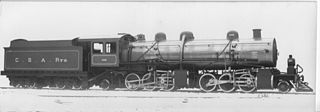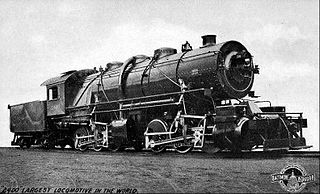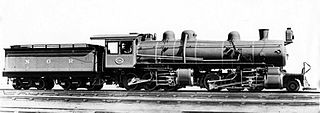
A Mallet locomotive is a type of compound articulated steam locomotive, invented by the Swiss engineer Anatole Mallet (1837–1919).

The Whyte notation is a classification method for steam locomotives, and some internal combustion locomotives and electric locomotives, by wheel arrangement. It was devised by Frederick Methvan Whyte, and came into use in the early twentieth century following a December 1900 editorial in American Engineer and Railroad Journal.

A 2-8-8-4 steam locomotive, under the Whyte notation, has two leading wheels, two sets of eight driving wheels, and a four-wheel trailing truck. The type was generally named the Yellowstone, a name given it by the first owner, the Northern Pacific Railway, whose lines ran near Yellowstone National Park. Seventy-two Yellowstone-type locomotives were built for four U.S. railroads.
Locomotive classification on the Pennsylvania Railroad took several forms. Early on, steam locomotives were given single-letter classes. As the 26 letters were quickly assigned, that scheme was abandoned for a more complex system. This was used for all of the PRR's steam locomotives, and — with the exception of the final type bought — all electric locomotives also used this scheme.
Under the Whyte notation for the classification of steam locomotive wheel arrangements, a 2-10-10-2 is a locomotive with two leading wheels, two sets of ten driving wheels, and a pair of trailing wheels.

In the Whyte notation for classifying the wheel arrangement of steam locomotives, an 0-8-8-0 is a locomotive with two sets of eight driving wheels and neither leading wheels nor trailing wheels. Two sets of driving wheels would give far too long a wheelbase to be mounted in a fixed locomotive frame, so all 0-8-8-0s have been articulated locomotives of the Mallet type, whether simple or compound. In the UIC classification, this arrangement would be, refined to Mallet locomotives, (D)D. The type was sometimes called Angus in North America.
A 2-8-8-2, in the Whyte notation for describing steam locomotive wheel arrangements, is an articulated locomotive with a two-wheel leading truck, two sets of eight driving wheels, and a two-wheel trailing truck. The equivalent UIC classification is, refined to Mallet locomotives, (1'D)D1'. These locomotives usually employ the Mallet principles of articulation—with the rear engine rigidly attached to the boiler and the front engine free to rotate—and compounding. The 2-8-8-2 was a design largely limited to American locomotive builders. The last 2-8-8-2 was retired in 1962 from the N&W's roster, two years past the ending of steam though steam was still used on steel mill lines and other railroads until 1983.

In the Whyte notation for the classification of steam locomotives by wheel arrangement, a 2-8-8-0 is a locomotive with a two-wheel leading truck, two sets of eight driving wheels, and no trailing truck.

Under the Whyte notation for the classification of steam locomotives, a 4-8-8-2 is a locomotive with four leading wheels, two sets of eight driving wheels, and a two-wheel trailing truck.

Under the Whyte notation for the classification of steam locomotives by wheel arrangement, a 2-6-6-2 is a locomotive with one pair of unpowered leading wheels, followed by two sets of three pairs of powered driving wheels and one pair of trailing wheels. The wheel arrangement was principally used on Mallet-type articulated locomotives, although some tank locomotive examples were also built. A Garratt locomotive or Golwé locomotive with the same wheel arrangement is designated 2-6-0+0-6-2 since both engine units are pivoting.
In Whyte notation, 2-4-4-2 refers to a railroad steam locomotive that has two leading wheels followed by two sets of four coupled driving wheels and two trailing wheels.

Under the Whyte notation for the classification of steam locomotives, a 0-6-6-0 wheel arrangement refers to a locomotive with two engine units mounted under a rigid locomotive frame, with the front engine unit pivoting and each engine unit with six coupled driving wheels without any leading or trailing wheels. The wheel arrangement was mostly used to describe Mallet locomotive types and in some occasions, Double Fairlie locomotives.
Under the Whyte notation for the classification of steam locomotives, a 2-8-8-8-4 has two leading wheels, three sets of eight driving wheels, and four trailing wheels.

A 2-6-8-0 steam locomotive, in the Whyte notation for describing locomotive wheel arrangements, has two leading wheels, a set of six driving wheels, a set of eight driving wheels, and no trailing wheels. These locomotives usually employ the Mallet principle of articulation, with a swinging front engine and a rigidly attached rear engine.

Under the Whyte notation for the classification of steam locomotives by wheel arrangement, 2-6-6-0 is a locomotive with one pair of unpowered leading wheels, followed by two sets of three pairs of powered driving wheels and no trailing wheels. The wheel arrangement was principally used on Mallet-type articulated locomotives. Some tank locomotive examples were also built, for which various suffixes to indicate the type of tank would be added to the wheel arrangement, for example 2-6-6-0T for an engine with side-tanks.
A triplex locomotive was a steam locomotive that divided the driving force on its wheels by using three pairs of cylinders to drive three sets of driving wheels. Any such locomotive will inevitably be articulated. All triplex locomotives built were of the Mallet type, but with an extra set of driving wheels under the tender. The concept was extended to locomotives with four, five or six sets of drive wheels. However, these locomotives were never built, except for one quadruplex locomotive in Belgium.

The South African Railways Class MA 2-6-6-0 of 1909 was a steam locomotive from the pre-Union era in the Natal Colony.
Under the Whyte notation for the classification of steam locomotives, a 2-8-8-8-8-2 has two leading wheels, four sets of eight driving wheels, and two trailing wheels. Because of its length, such a locomotive must be an articulated locomotive. It is not longer than a normal articulated; the fourth set of drivers is located under the tender.
Under the Whyte notation for the classification of steam locomotive wheel arrangements, a 4-4-6-2 is a locomotive with two pairs of leading wheels, one set of four driving wheels, a second set of six driving wheels, and a pair of trailing wheels.
A multiplex locomotive is a steam locomotive that divides the driving force on its wheels by using multiple pairs of cylinders to drive multiple driving wheel set groups. Such a locomotive will necessarily articulated if it has more than two sets of driving wheels. There were locomotive projects with three, four, five or six sets of drive wheels. However, these locomotives were never built, except for four triplex locomotives in the United States and one quadruplex locomotive in Belgium.










